Analogue Resurgam - A survey of a selection of compact
disc reissues by High Definition Tape Transfers
HDTT is an enthusiast reissue label you will come to know via
their website. There's some valuable, attractive and very agreeable
and sometimes really striking material in this catalogue. Have
a look at www.highdeftapetransfers.com.
They’re pretty active and new issues appear at a rate of knots.
Their inspiration, mission and speciality is the caring perfectionist
issue of transfers sourced from commercial reel-to-reel tapes
issued widely in the USA during the period 1955-1980. The results
can be staggering.
Formats Available:
Compact Disc Burned on a Gold CD-R
HQCD (High Quality Compact Disc) Playable on all compact disc
players
24bit 96khz Resolution DVD Playable on all DVD players
24bit 96khz Resolution Flac Downloads Playable through most
media players
24bit 192khz Resolution Flac Downloads Playable through most
media players
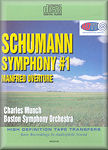 Robert
SCHUMANN (1810-1856)
Robert
SCHUMANN (1810-1856)
Symphony no. 1 (1841) [29:30]
Manfred Overture (1849) [11:20]
Boston Symphony Orchestra/Charles Munch
rec. Boston, 1955 (Sym 1); 1961 (Manfred). ADD
HIGH DEFINITION TAPE TRANSFERS HDCD 125 [40:26]
www.highdeftapetransfers.com.
The Munch Schumann imparts a nicely rendered woof and bark to
the Boston horn benches. A good sense of distance is conveyed
at 1:34 and at 4:53 in the finale. You can also hear it in the
invocatory trumpets through the analogue hiss which is an inescapable
yet exciting part of the listening experience. The first movement
radiates a Cantelli-like fury while the Larghetto drags the
message with an infinitely sweet slowness across the mind's
sensors. The scherzo does not fly but there’s no doubt of its
vehemence – in fact to the point of relentless. If you like
your Schumann Ferrari style then the outer movements will suit
your tastes. Munch certainly keeps the gas flowing so much so
that one occasionally daydreams one is listening to Berlioz.
There is humour here too in this rattlingly tight and exciting
performance. We could have done with a longer gap before the
fiery Manfred in which the whip-crack unanimity of the
surging strings is memorable. They also have sumptuous tawny
tone and weight (6.05).
On the downside: nowhere is the total playing time declared.
HDTT are not always strong on presentation. There’s lots of
data about the transfer process from analogue source. I am not
at all sure that all those technical details matter enormously
to most music-lovers.
Rob Barnett
Vehemence
to the point of relentless. Sumptuously tawny tone and weight
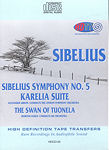 Jean
SIBELIUS (1865-1957)
Jean
SIBELIUS (1865-1957)
Symphony No. 5 (1915-19) [30:07]
Karelia Suite (1893) [13:35]
London Symphony Orchestra/Alexander Gibson
The Swan of Tuonela (1893) [8:34]
Morton Gould and his Orchestra
rec. no details supplied but must be 1950s transferred from
RCA 4 track tapes. ADD
HIGH DEFINITION TAPE TRANSFERS HDCD 129 [52:18]
www.highdeftapetransfers.com.
HDTT are not sure about the number of the disc? It says 119
on the back of the case not 129. This is a good version of Sibelius
5 with some nice picking out of detail in the 4 track tapes.
They include subtly tolling horn work in I at 2.03. this touch
normally disappears into the miasma. Gibson is tense and quick
and the strings rustle and buzz nicely. Try 3.40 in I and at
the start of III. The music boils to a high tension accelerando
at end of I. There is superbly pointed playing in II. In
the third movement there’s a nicely sustained tempo and tension
over the carolling horns. It is just a shade fast to bring out
the last ounce of grandeur. On the other hand the growl and
snorty snarl of the strings at 4:54 onwards has never been done
as well. Through the hiss Gibson is frankly wonderful towards
the end of the work. Gibson's Karelia shows all the same
virtues as the symphony. He delivers a goodly, humming, taut
and rhythmically sharp approach. The dignified but hurried middle
movement showing that same proclivity for speed that we heard
in parts of the Fifth Symphony. The trumpets rap out and full
brass blare. These transfers sound refreshingly clean – despite
the hiss - and are a pleasure to hear.
Gould's slithery Swan of Tuonela is superb. It’s very
much in your face as a recording. There’s none of the distancing
magic we feel in the Munch Schumann 1. Solo cello and the lovely
cor anglais solos reach out to the listener with needy tendrils.
OK so the strings may be bathed in limelight but the result
is very pleasing and a world away from autopilot. What we hear
is a sort of Stars and Stripes intensity to be found
in Soviet refection in the Mravinsky-Moscow version of the 1960s.
Here though there is a much more gripping focus on the cor anglais.
So what we have here is a really gripping version of The
Swan that all Sibelians need to hear. It has an epic stride
and superbly conveyed tension complete with creaking chairs.
It is completely idiomatic. The harp basso line at end is audible
and in your face. It greatly enhances the very special effect
of this reading.
The hiss already mentioned seems to be the hiss of the original
tapes. There’s no disorientating drop-out of digital silence
between tracks.
It’s a shame that the notes do not give date of death for Gibson.
His dates are 1926-1995.
Use of DVD cases was standard for HDTT. This practice rather
set them apart and recalls the shelving issues raised by the
same DVD Audio issues derived from Vanguard and Vox. Then again
storage styles have varied. Remember those strange little grey
storage boxes in which BASF cassettes were first issued in the
period 1969-71 before Bavaria saw the light? Newer issues are
in standard cases.
I hope there are more of these reel to reel reissues to come.
Rob Barnett
Gibson
is tense and quick and the playing is superbly pointed and Gould’s
is a really gripping version of The Swan
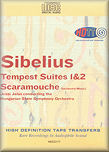 Jean
SIBELIUS (1865-1957)
Jean
SIBELIUS (1865-1957)
Tempest Suites 1 and 2 [21:31 + 15:04]
Scaramouche (incidental music) [21:17]
Hungarian State Symphony Orchestra/Jussi Jalas
rec. 1972. ADD
Transferred from a London 4-track tape
HIGH DEFINITION TAPE TRANSFERS HDCD 125 [40:26] www.highdeftapetransfers.com.
Jussi Jalas and his Hungarian orchestra appeared on a sequence
of mid-price LPs from Decca in the 1970s. Their recordings of
rare Sibelius incidental music were perhaps eclipsed by Decca’s
top line issues including those from Maazel and from Horst Stein
and the Suisse Romande. The recordings were once available with
much of the rest of Jalas’s series of Sibelius incidental music
on a Double Decca 448 267-2 issued circa 1996 but long deleted.
In the next two years we will see the completion of the Bis
Sibelius Edition. Ondine, EMI and Chandos have filled in many
gaps over the years. The often overlooked Ondine deserve special
kudos for making a living performing reality of so much rare
Sibelius and doing it in resounding style. Thirty plus years
ago the Sibelius landscape was much more sparse. Circa 1969-72
a series of Decca ADD prefix mid-price LPs arrived on the scene.
The conductor Jussi Jalas (1908-85) was the son-in-law of Sibelius
via his daughter Margareta. He conducted the first performance
of Kullervo in modern times. With the Hungarian State
Symphony Orchestra he recorded the Lemminkainen Legends and
several discs of incidental music. The LPs received a muted
welcome. Now we can encounter a selection of the Sibelius-Jalas
incidental music recordings again courtesy of HDTT and their
revival of Decca reel-to-reels.
HDTT's presentation is a bit spotty again. There are no track
titles at all and no timings for the Tempest tracks though we
do get a single timing for the one track [21:02] Scaramouche
Suite. The Decca/London analogue tape stock must have been
in good heart because there are no blips and only a discreet
and forgettable analogue ‘hush’. This is Decca caught at one
of its peak vintage periods.
The Tempest movements here are The Oak Tree, Humoreske,
Caliban's Song, The Harvesters, Canon, Scene, Intrada – Berceuse,
Entr'acte - Ariel's Song, The Storm, Chorus of Winds, Intermezzo,
Dance of the Nymphs, Prospero, Songs 1 & 2, Miranda - The
Naiads, Dance – Episode.
The 13 tracks of the two Tempest suites remind us how
otherworldly Sibelius's invention had become in the 1920s. Tracks
such as tr. 9 transport us to another raw expressionist reality.
However if you need The Tempest in suite form then do
track down the Beecham on Sony
(the Beecham is in venerable but grainily engaging sound), the
astonishingly good Reference
Recordings by Stern in Kansas. If you hanker after the full
score then Ondine on ODE 914-2 or Bis.
HDTT provide very full notes on both pieces. Neither of these
pieces are Sibelius in unambiguously merry mode. They are not
comparable with King Christian II for example. There
are however some lighter-hearted moments - what a masterly score.
The Tempest will by now be broadly familiar to many enthusiasts
but this was the first recording of Scaramouche – the
incidental music to Poul Knudsen's ‘tragic pantomime’. There
is much impudent woodwind writing in evidence, chilly and brisk,
wistful and romantic. Some pleasingly ‘sticky’ string solos
are juxtaposed with tambourine. A silvery deckle-edged halting
dance can be heard at 11.30 and there is a touch of Nutcracker’s
grand guignol along the way. It's such a pity that the whole
suite is in a single indigestible track but that's the way it
was when originally issued. Scaramouche can also be heard
on Bis.
Presentation: The disc itself says one track for each of the
two Tempest suites and one for Scaramouche. Take
no notice. The rear insert is correct 10 tracks for suite 1,
3 tracks for suite 2 and one for Scaramouche.
Rob Barnett
Decca caught at one of its peak vintage periods
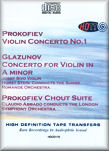 Sergei
PROKOFIEV Violin Concerto No.1 [20:09]
Sergei
PROKOFIEV Violin Concerto No.1 [20:09]
Alexander GLAZUNOV Concerto
for Violin in A minor () [18:46]
Josef Sivo (violin)
Suisse Romande Orchestra/Horst Stein
rec. 1971, Victoria Hall, Geneva
Sergei PROKOFIEV
Chout Suite [25:19]
London Symphony Orchestra/Claudio Abbado
rec. 1966. ADD
HIGH DEFINITION TAPE TRANSFERS HDCD 170 [40:26]
www.highdeftapetransfers.com.
I discovered the Glazunov Violin Concerto through a broadcast
of the LP counterpart of the first two works on this disc. It
was Decca SXL6532 and came out at a time when the composer had
a very fragmentary representation in the shops. Apart from the
odd symphony on EMI-Melodiya your best chance of gradually hearing
the nine symphonies was at that time on Radio 3. This was usually
courtesy of a regional BBC orchestra – often the BBCNSO. Now
we have multiple versions of the symphonies. I recently noticed
that even the ‘lost’ Fedoseyev LP Glazunov symphony cycle can
be had for as little as £5.99 as an mp3 download on Amazon.
What drew me to this HDTT disc was the Glazunov. In the 1970s
I played my off-air cassette tape to death. I virtually ‘imprinted’
on the Glazunov – it was the first time I had heard the work.
No other version since then has come anywhere near it – except
perhaps the Julian Sitkovetsky version. I have not heard the
Shumsky (Chandos) but have high hopes of it. Hearing the Sivo
again and hearing it repeatedly has been no disappointment.
Sivo and Stein find the work’s singing heart and the song unwinds
fluently. The Prokofiev Concerto is similarly blessed with a
wonderful equipoise between sun-bathed clarity and hoarsely
expressed mystery. It’s all very closely and pleasingly recorded
– very different from the more naturally and perhaps subtly
recorded yet equally engaging Vilde Frang version just issued
on EMI. Abbado’s Chout is from a different LP. The work
has more musicality and romance than I recall from my first
hearing. That 1980s BBC broadcast was given by the BBCSO with
Rozhdestvensky and the part-serious part-chuckling narrator
was none other than Andrew Cruickshank.
Again HDTT make us wonder about the catalogue number by identifying
this as HDTT 167 on the back of the case insert. The correct
number is as above.
Rob Barnett
Sun-bathed
clarity and hoarsely expressed mystery all very closely and
pleasingly recorded
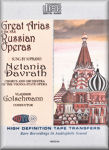 Great
Arias from Russian Operas sung by Netania Davrath
Great
Arias from Russian Operas sung by Netania Davrath
Pyotr Ilyich TCHAIKOVSKY Eugene
Onegin - Tatiana’s letter scene [13:44]
Nikolai RIMSKY-KORSAKOV Sadko
- Volkhova’s Lullaby [3:49]; The Snow Queen – Snow Maiden’s
Aria [4:22]
Pyotr Ilyich TCHAIKOVSKY
Queen of Spades – Lisa’s aria act III [5:10]
Mikhail GLINKA A Life for
the Tsar - Romance of Antonida [4:25]
Alexander BORODIN Prince
Igor - Yaroslavna’s Lament (Act IV) [10:35]
Sergei RACHMANINOV Chanson
Georgienne [4:45]
Netania Davrath (soprano)
Chorus and Orchestra of the Vienna State Opera/Vladimir Golschmann
Utah Symphony Orchestra/Maurice Abravanel
rec. no details. ADD
Transferred from a Vanguard 4 Track Tape.
HIGH DEFINITION TAPE TRANSFERS HDCD 133 [40:26]
www.highdeftapetransfers.com.
HDCD 133 is rather short in playing duration. The centre of
attention here is the soprano Netania Davrath (1931-1987). She
emigrated to Israel in 1948. Davrath has an indelible place
in the catalogue for her Vanguard recordings of the Songs
of the Auvergne as arranged by Joseph Canteloube. Her voice
is unmistakable – girl-like sweetness yet with a hoarse bass-deep
timbre. This is, as the title proclaims, a collection of Great
Arias from Russian Operas. Davrath was born in the Ukraine
and has the idiom to a T. She is aptly soulful as Tatiana in
the Onegin Letter Scene yet she has plenty of operatic
rhetoric when called for. She is similarly impressive in the
Sadko excerpt: Princess Volkhova's Lullaby with
its silvery magic. Golschmann draws fine playing from the Vienna
State Opera Orchestra. The Queen of Spades aria with
its ominous subtext is projected by Davrath with a real shiver.
It’s classic Tchaikovskian operatic work. In Glinka’s A Life
for the Tsar the Romance of Antonida from Act III
radiates a lovely sense of choral distance caught in the recording
array. Again there is some confusion over tracks between the
insert and the tracks on the disc but that is no obstacle to
the enjoyment to be had from Chanson Georgienne which
tenderly conveys those Russian oriental nights, sensuously alive
with wafted and exotic spiced scents.
Presentation again needs more attention. The sung words are
not printed and one of the title lines has been truncated. Still,
where else can you experience the wondrous voice of Netania
Davrath in this repertoire? Even so, with a little more attention
to detail and proofing these HDTT items could be unassailable.
Rob Barnett
Davrath
is unmistakable – girl-like sweetness with a hoarse bass-deep
timbre.
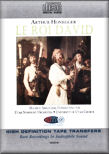 Arthur
HONEGGER
Arthur
HONEGGER
Le Roi David (King David) [69:46]
Netania Davrath (soprano); Marvin Sorenson (tenor); Jean Preston
(mezzo); Martial Singher (narrator); Madeleine Milhaud (Witch
of Endor)
The University of Utah Chorale
Utah Symphony Orchestra/Maurice Abravanel
rec. early 1960s ADD
Transferred from a Vanguard 4-track tape
HIGH DEFINITION TAPE TRANSFERS HDCD 161 [69:46]
www.highdeftapetransfers.com.
Le Roi David is not that commonly encountered on disc.
Here it is accorded a very satisfying sound in wonderful stereo.
It is all that analogue should be and has a powerfully resonant
close-up quality. Martial Singher orates in resounding confident
French with the whole work having the statuesque effect of Stravinsky’s
Oedipus Rex. Davrath is tested by Honegger’s long vocal lines
with bar after bar allowing few nodes for taking of breath.
Despite the evidence of the insert the work is not presented
in only three tracks - it is in fact generously tracked and
proceeds in a series of small pieces of mosaic. Marvin Sorenson
is forthright of tone but then so is Davrath who was carefully
coached for this recording as was the University of Utah Chorale.
The music is very tonal perhaps a little in the manner of early
Britten and even Poulenc with touches of Stravinsky also in
evidence. There are a few catchy jazzy moments as in tr. 11
with the chorus at that point quite euphoric almost in the manner
of the celebratory writing of Howard Hanson. There’s a lot of
narration. Madeleine Milhaud is the Witch of Endor and she gurglingly
hams it up with little held back. Davrath at one point lets
loose a wonderfully ululating call intertwining with the vocalisation
of Jean Preston. Singher’s resonant voice also sparks the imagination
when heard against the backdrop of the wailing of the choir
(like the vocalisation in RVW's Flos Campi) as it does
in the final sunset ecstasy at tr.27. Not all of Honegger’s
writing is monumental. There is the pastoral piping of tr. 16
- in part predicting the sweetness of Walton's Henry V music
for desolated post-Agincourt France. In tr. 22 with its the
dancing tambourine we are reminded of Davrath’s Canteloube triumphs
– also for Vanguard. The rasping barbaric fanfares of tr.23
(Vainqueur de tous ses enemis) provide a provocative contrast.
The final alleluias are a complete delight.
If you have not yet discovered King David – also termed a dramatic
psalm - then do try this as a fine introduction in sound that
is stable, squat and pleasing to the ear.
A stunning triumph of a transfer of a classics recording of
a blissful work.
For the sung text in French and English you will need to go
to the website for HDTT.
Rob Barnett
A stunning triumph of a transfer
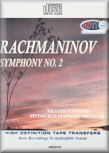 Sergei
RACHMANINOV (1873-1943)
Sergei
RACHMANINOV (1873-1943)
Symphony No. 2 in E minor op. 27 (1907) [45:34]
Pittsburgh Symphony Orchestra/William Steinberg
rec. ADD. From a Command Classics 4 track tape. HIGH DEFINITION
TAPE TRANSFERS HDCD116 [45:34]
www.highdeftapetransfers.com.
William Steinberg was born Hans Wilhelm Steinberg in Köln, Germany
1 August 1899. There he studied with Hermann Abendroth. As director
at the Frankfurt Opera he conducted the premiere of Schoenberg's
Von Heute auf Morgen in 1930. The Nazi regime drove him
from Frankfurt and then from Germany. With Bronislav Hubermann
he left Germany and founded the Palestine Symphony (later the
Israel Philharmonic) becoming its musical director. There he
was noticed by Toscanini and cozened into various conducting
posts and engagements in 1940s USA. He was Music Director of
the Buffalo Philharmonic from 1945 until 1953. Their first commercial
recording was on Musicraft: Shostakovich’s Leningrad.
From Buffalo he moved to the Pittsburgh Symphony Orchestra in
1952. He was Music Director of the Boston Symphony Orchestra
from 1968 until 1972. He made a famous recording of Holst's
The Planets with the Boston Symphony. It was a frontline
fixture of the DG catalogue for many years during the LP era.
His illustrious premieres included Copland’s Billy the Kid,
Lukas Foss's Choral Symphony and Roger Sessions' Symphony No.8.
He died in New York City on 16 May 1978.
Until I heard this HDTT disc I had not encountered Steinberg's
1966 Rachmaninov Second Symphony. It came out at about the same
time as the Boult and Previn cut versions. Here it is in a transfer
by HDTT on to HDCD116 - although the insert says HDVD116. The
C and V are close to each other on the QWERTY keyboard. Steinberg
while applying the accustomed cuts delivers a very nicely weighted
rendering of the more intimate pages and of the detailing. His
excellent horn bench adds a glowing halo and warm glower over
the proceedings. Rozhdestvensky takes a lot of beating in this
work as does Cura and the very different Sanderling but this
is a grand performance which despite the elisions in the Adagio
still cuts the mustard. It proves that those who grew up in
the days when Rachmaninov was a guilty pleasure were encountering
idiomatic performances. It’s well worth hearing.
HDTT have not displayed any total timings on the insert but
the music is the thing. We are regaled with a full page of notes
in the DVD case insert but I would have liked to know what the
speed of playback of the reel was - presumably 7½" per
second?
By the way, an earlier mono recording of this Symphony by same
conductor and orchestra can be heard on EMI Classics Archivcd
CDM 7243 5 6654 2 3. It was first released on Capitol Classics
P 8290 and comes from sessions at Syria Mosque, Pittsburgh.
Rob Barnett
A
grand performance – with cuts – from the days when Rachmaninov
was a guilty pleasure. Well worth hearing.
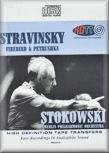 Igor
STRAVINSKY (1882-1971)
Igor
STRAVINSKY (1882-1971)
Firebird suite (1910) [22:00]
Petrushka suite (1911) [15:24]
Berlin Philharmonic Orchestra/Leopold Stokowski
rec. 1958, from a Capitol reel-reel recording. ADD
HIGH DEFINITION TAPE TRANSFERS HDCD112 [37:21]
www.highdeftapetransfers.com.
This represents short playing time but Stokowski’s voluptuously
proportioned and lavishly recorded performances are well worth
hearing even if both works appear here in truncated suites.
The finale of The Firebird whooping rip and snort of
the brass is very enjoyable but the cavernous bass drum sounds
pretty ho-hum routine. Compare that with the wonderful recording
of the complete ballet by the LSO and Dorati once issued on
a Contour LP and more accessibly on a Mercury CD. Even so there’s
a rattlingly good brass snarl from the strait-laced Berliners
in Infernal Dance. The Stoki Petrushka capsule
is full of vitality and bustle. The propulsive power of the
penultimate track is just wonderful. It comprises Russian dance,
Cell of Petrushka, Mardi Gras Fair, Nursemaid’s Dance, Russian
Peasant Bear, Gypsies and Rake Vendor, Dance of Coachmen and
Masqueraders. This version brings out the character of the players
but with less precision than I had expected from the BPO. The
unembarrassed 1958 sound for the solo piano is nothing short
of over-sized and imperious.
There are full notes but rendered in what appears to bubble-jet
small print which at this font-size is already developing signs
of illegibility.
Rob Barnett
The
whooping rip and snort of the brass … characterful versions
but with less orchestral precision than I had expected
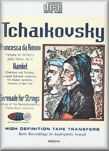 Pyotr
Ilyich TCHAIKOVSKY (1840-1893)
Pyotr
Ilyich TCHAIKOVSKY (1840-1893)
Francesca da Rimini (1876) [23:02]
Hamlet Overture (1888) [19:07]
Serenade for Strings (1880) [26:33]
Stadium Symphony Orchestra of New York/Leopold Stokowski (Francesca;
Hamlet)
Strings of the Boston Symphony/Charles Munch (Serenade)
rec. 1958. ADD
HIGH DEFINITION TAPE TRANSFERS HDCD141 [68:42]
www.highdeftapetransfers.com.
Francesca and Hamlet have been issued before on
Everest
CD. How audacious it was of the Everest team to put two
such neglected works side by side back in the late 1950s. It
would have been so easy to have put either work in harness with
Romeo and Juliet. It’s in glorious sound though a hint
of rage in the treble evidences the age of these classic session
tapes. The fervour of Francesca is remarkable. However if you’re
in the market for incandescence don’t overlook Ovchinnikov's
Soviet era recording now deleted on Olympia OCD139 but occasionally
available second-hand; I had overlooked it until our
reviewer Nick Barnard put me on the right track. That said,
I still hanker after a BBC broadcast from summer 1978 of Yuri
Ahronovich conducting the LSO in one of the grandest and most
furious Francescas ever and a superb Manfred which
knocks spots off the lumpy Manfred he recorded soon after
with the same orchestra on DG. Come on BBC Legends – let’s hear
that concert. Also perhaps Regis could secure the Ovchinnikov
Francesca and issue it with the same conductor’s Romeo.
Not sure what else Ovchinnikov recorded but it is clearly worth
looking out and sifting for the gold which his Francesca
most certainly is. He was a composer as well and wrote at
least one symphony and film music. Most regrettably HDTT cut
off the hall resonance from the end of Stokowski’s Francesca.
As for the lower key Hamlet it’s the best I have heard.
It rings out with magnificently intense and brow-knitting concentration.
There’s a noticeable shadow of print-through pre-echo on the
Munch at the start. This is a momentary distraction from what
is a power-house performance that is the aural equivalent of
an over-engined Cadillac. Still, it certainly captures that
huge Boston sound in all its amplitude and sometimes ferocity
as in the case of Munch’s Schumann. In the finale the accelerator
is pinned to the floor in what is a very exciting precision-defined
thundering performance. Charm is perhaps thin on the ground
but one would never call this anonymous.
The two tone poems are from a 1958 Everest two track tape while
the Serenade derives from an RCA two track of the same vintage.
It’s a pity that HDTT they did not include the serial numbers
of the reel to reel tapes - the anorak in me coming out again.
There should have been a separate track for each movement of
the Serenade.
Another eccentric HDTT production yet with a draw to it. The
notes comprise a full side devoted to Francesca but not
a word about Hamlet or the Serenade. Timings are
however given for each the three works. Francesca is a gramophone
classic – truly a red hot production. Now if only DHTT could
do transfers of historic Melodiya tapes such as Ovchinnikov’s
whirlwind Francesca.
Rob Barnett
A
red hot production

